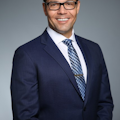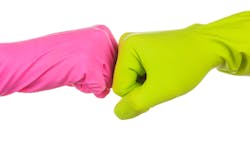Science and research influenced health policy during the COVID-19 pandemic
The SARs-CoV-2 virus has infected and impacted millions of people worldwide. SARS-CoV-2, or COVID-19, is transmitted primarily through person-to-person contact, as well as via virus-containing aerosols.1 Transmission via aerosol-generating procedures (AGPs) led many to believe that dental care could put dental professionals and their patients at risk.
The American Dental Association (ADA) created interim guidance on the use of enhanced personal protective equipment (PPE).2 Additionally, the ADA Science & Research Institute (ADASRI) and the ADA Health Policy Institute (HPI) joined forces in 2020 to develop a longitudinal approach to define the rates of COVID-19 infection among dentists, which resulted in numerous webinars and two papers published in the Journal of the American Dental Association (JADA).3,4
Steps prove successful
The first paper showed that the prevalence of COVID-19 among US dentists was low (0.9%; 95% CI: 0.5%–1.5%).3 The second study reported a low prevalence rate (2.6%) in a six-month period, and monthly incidence rates ranging from 0.2%–1.1%, which reflects the high level of safety among dentists.4
The low monthly incidence of disease, despite several regional and national COVID-19 rate spikes during the study period, may indicate that dentists were able to mitigate much of their COVID-19 risk in clinical environments through consistent use of enhanced PPE and by adhering to interim CDC and ADA guidance. The risk of SARS-CoV-2 infection decreases substantially with appropriate PPE use.5
Additionally, dental practices found ways to provide care while minimizing the physical presence of patients in dental settings. As part of the recurring web survey of 3,000 US dentists by HPI, it was learned that while dental practices were closed due to COVID-19 in April 2020, 24.8% of practices used teledentistry, and after dental practices reopened, this rose to 37.3% by February 2021.6
The level of adherence to enhanced infection control procedures in response to the COVID-19 pandemic continues to be very high among US dentists. Dental care is being delivered safely because dentists are demonstrating adherence to very strict protocols that help protect their patients, dental teams, and themselves.
Most recently, the ADA was pleased with the Occupational Safety and Health Administration’s (OSHA) decision that dental practices are largely exempt from the new emergency temporary standard for COVID-19 set for health-care settings. The ADASRI/HPI research most likely provided scientific evidence to support the safety of dental settings.7 This is a great example of how science generated by the ADA can directly influence policy.
Editor's note: This article appeared in the September 2021 print edition of Dental Economics.
References
1. Interim infection prevention and control guidance for dental settings during the COVID-19 response. Centers for Disease Control and Prevention. December 4, 2020. Accessed January 13, 2021. https://www.cdc.gov/coronavirus/2019-ncov/hcp/dental-settings.html
2. COVID-19 Practice Resources. American Dental Association. Accessed July 9, 2021. https://success.ada.org/en/practice-management/patients/practice-resources
3. Estrich CG, Mikkelsen M, Morrissey R, et al. Estimating COVID-19 prevalence and infection control practices among US dentists. J Am Dent Assn. 2020;151(11):815-824.
4. Araujo MWB, Estrich CG, Mikkelsen M, et al. COVID-19 among dentists in the United States: A 6-month longitudinal report of cumulative prevalence and incidence. J Am Dent Assn. 2021;152(6):425-433.
5. Seidelman JL, Lewis SS, Advani SD, et al. Universal masking is an effective strategy to flatten the severe acute respiratory coronavirus virus 2 (SARS-CoV-2) healthcare worker epidemiologic curve. Infect Control Hosp Epidemiol. 2020;41(12):1466-1467.
6. Fossi C, Estrich C, Mikkelsen M, et al. COVID-19 pandemic related dental practice trends on teledentistry. IADR/AADR 2021 Annual session. Abstract #0886. 2021.
7. Dentistry largely exempted from new COVID-19 workplace regulations. American Dental Association. June 14, 2021. Accessed July 8, 2021. https://www.ada.org/en/press-room/news-releases/2021-archives/june/dentistry-and-new-covid-19-workplace-regulations
Marcelo W.B. Araujo, DDS, PhD, MS, is the CEO of ADASRI and the ADA chief science officer. He provides strategic leadership and management for ADASRI, develops collaborative opportunities for key scientific initiatives of the ADA, and is at the forefront of emerging scientific issues that affect public health, patient care, dental practice, and health programs. He holds a DDS degree and a periodontology certificate. His scientific credentials include an MS in oral science and a PhD in epidemiology, and he completed a Fellowship in periodontology teaching and clinical research. Most recently, Dr. Araujo received the Kellogg Executive Scholar Certificate in nonprofit management.
Cameron Estrich, MPH, PhD, is a health research analyst at ADASRI. She received an MPH in epidemiology and a PhD in community health sciences from University of Illinois at Chicago. Dr. Estrich now studies policy implementation, dental professionals’ occupational health, and trends in dental treatment in the US civilian population.
About the Author

Marcelo W.B. Araujo, DDS, PhD, MS
Marcelo W.B. Araujo, DDS, PhD, MS, is the CEO of ADASRI and the ADA chief science officer. He provides strategic leadership and management for ADASRI, develops collaborative opportunities for key scientific initiatives of the ADA, and is at the forefront of emerging scientific issues that affect public health, patient care, dental practice, and health programs. He holds a DDS degree and a periodontology certificate. His scientific credentials include an MS in oral science and a PhD in epidemiology, and he completed a Fellowship in periodontology teaching and clinical research. Most recently, Dr. Araujo received the Kellogg Executive Scholar Certificate in nonprofit management.

Cameron Estrich, MPH, PhD
Cameron Estrich, MPH, PhD, is a health research analyst at ADASRI. She received an MPH in epidemiology and a PhD in community health sciences from University of Illinois at Chicago. Dr. Estrich now studies policy implementation, dental professionals’ occupational health, and trends in dental treatment in the US civilian population.
